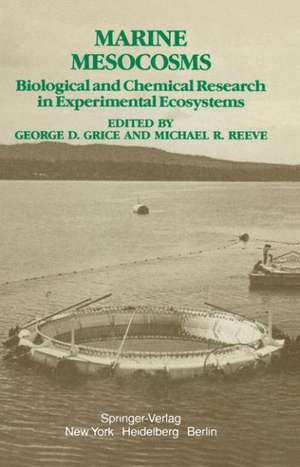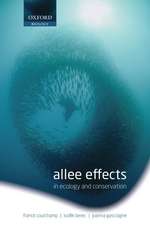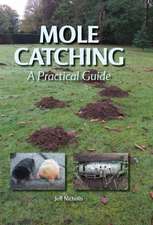Marine Mesocosms: Biological and Chemical Research in Experimental Ecosystems
Editat de G.D. Grice, M.R. Reeveen Limba Engleză Paperback – 27 dec 2011
Preț: 647.92 lei
Preț vechi: 762.26 lei
-15% Nou
Puncte Express: 972
Preț estimativ în valută:
123.98€ • 135.09$ • 104.47£
123.98€ • 135.09$ • 104.47£
Carte tipărită la comandă
Livrare economică 23 aprilie-07 mai
Preluare comenzi: 021 569.72.76
Specificații
ISBN-13: 9781461256472
ISBN-10: 146125647X
Pagini: 448
Ilustrații: 430 p.
Dimensiuni: 155 x 235 x 27 mm
Greutate: 0.63 kg
Ediția:Softcover reprint of the original 1st ed. 1982
Editura: Springer
Colecția Springer
Locul publicării:New York, NY, United States
ISBN-10: 146125647X
Pagini: 448
Ilustrații: 430 p.
Dimensiuni: 155 x 235 x 27 mm
Greutate: 0.63 kg
Ediția:Softcover reprint of the original 1st ed. 1982
Editura: Springer
Colecția Springer
Locul publicării:New York, NY, United States
Public țintă
ResearchCuprins
o.- 1 Introduction and Description of Experimental Ecosystems.- 2 Experimental Marine Ecosystem Enclosures in a Historical Perspective.- 3 Application of Enclosures to the Study of Marine Pelagic Systems.- 4 Application of Enclosures to Studies on the Early Life History of Fishes.- 5 Application of Enclosures to the Study of Ocean Chemistry.- 6 Radiotracers in Studies of Trace Metal Behavior in Mesocosms: Advantages and Limitations.- 7 Natural Radionuclides as Tracers for Geochemical Processes in MERL Mesocosms and Narragansett Bay.- 8 Controlled Marine Ecosystems-A Tool for Studying Stable Trace Metal Cycles: Long-Term Response and Variability.- 9 Fate of Radiolabeled Polycyclic Aromatic Hydrocarbons and Pentachlorophenol in Enclosed Marine Ecosystems.- 10 Biogeochemistry of Volatile Organic Compounds in Marine Experimental Ecosystems and the Estuarine Environment-Initial Results.- 11 The Use of Experimental Ecosystems for Evaluating the Environmental Impact of Pollutants: A Comparison of an Oil Spill in the Baltic Sea and Two Long-Term, Low-Level Oil Addition Experiments in Mesocosms.- 12 Processes Affecting the Movement and Speciation of Mercury in the Marine Environment.- 13 Ecotoxicological Experiments with Marine Plankton Communities in Plastic Bags.- 14 Plankton Spring Development in a South Norwegian Fjord.- 15 The Plankton Tower. IV. Interactions Between Water Column and Sediment in Enclosure Experiments in Kiel Bight Victor Smetacek, Bodo von Bodungen, Bastiaan Knoppers,.- 16 Replication in Controlled Marine Systems: Presenting the Evidence.- 17 Predator Control in Enclosures.- 18 Food and Growth of Juvenile Herring, Clupea harengus pallasi, in CEPEX Enclosures.- 19 Sedimentation of Phytoplankton Cells Within Controlled Experimental Ecosystems Following Launching, and Implications for Further Enclosure Studies.- 20 Phytoplankton Sinking-Rate Dynamics in Enclosed Experimental Ecosystems.- 21 The Manipulation of Physical, Chemical, and Biological Factors to Select Species from Natural Phytoplankton Communities.- 22 The Use of Enclosed Experimental Ecosystems to Study Nitrogen Dynamics in Coastal Waters.- 23 Microbial Contribution to Overall Plankton Community Respiration-Studies in Enclosures.- 24 The Importance of Understanding Phytoplankton Life Strategies in the Design of Enclosure Experiments.- 25 Phytoplankton Species' Responses to Nutrient Changes in Experimental Enclosures and Coastal Waters.- 26 The Population Biology of the Larvacean Oikopleura dioica in Enclosed Water Columns.- 27 Trophic Interactions and Production Processes in Natural Zooplankton Communities in Enclosed Water Columns.- 28 The CEPEX Approach and Its Implications for Future Studies in Plankton Ecology.- 29 How Can Enclosing Seawater Liberate Biological Oceanographers?.- 30 The Future of Controlled Ecosystem Enclosure Experiments.
















